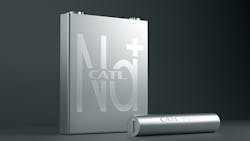Sodium-Ion Batteries Achieve 160-Wh/kg Energy Density, Fast Charging
What you'll learn:
- How does a sodium-ion battery compare to a lithium-ion battery?
- How did CATL overcome the inherent issues associated with sodium ions?
- What steps are being taken to bring the Na-ion battery to the commercialization stage?
Lithium-ion batteries have demonstrated their superior energy density, energy efficiency, and long cycle life. Today they power electric and low-emission plug-in hybrid vehicles in addition to use in stationary energy-storage applications.
However, as electric vehicles (EVs) become increasingly popular, demand for battery ingredients has expanded rapidly, resulting in most easily accessible lithium reserves becoming either geographically remote or located in politically sensitive areas. As a result, car and battery makers are seeking alternatives to lithium, the current main chemistry of EV batteries.
Enter the sodium-ion battery. The low cost, benign environmental impact, and natural abundance of sodium (Na) resources have made Na-ion batteries a possible competitive alternative to their lithium counterparts for large-scale applications.
Sodium-Ion vs. Lithium-Ion
Sodium-ion batteries have a similar working principle to lithium-ion devices. In both, the ion travels between anode and cathode, losing or absorbing electrons. Sodium is one of the most abundantly available elements in the earth's crust and can be mined by performing electrolysis on sodium chloride. However, compared with lithium ions, sodium ions have a larger volume and higher requirements regarding structural stability and the kinetic properties of materials. This in the past has been a bottleneck for the industrialization of sodium-ion batteries.
Contemporary Amperex Technology Co. Inc. (CATL) was able overcome those issues. In a “Tech Zone” online launch event, CATL chairman Dr. Robin Zeng unveiled the company’s first-generation sodium-ion battery, together with its AB battery-pack solution, which is able to integrate sodium-ion cells and lithium-ion cells into one pack.
The CATL battery shows an energy density, of 160 Wh/kg. While that’s a little short of the 200 Wh/kg achieved by the lithium-iron-phosphate (LFP) devices CATL ships to its clients such as Tesla, Dr. Zeng has already suggested the second generation of Na-ion batteries will reach the 200 Wh/kg mark.
The sodium-ion product does already meet or exceed other electrochemical properties. CATL’s first generation of sodium-ion batteries is said to have the advantages of fast-charging capability, excellent thermal stability, low-temperature performance, and high-integration efficiency, among others. According to the company it can charge to 80% in just 15 minutes.
In addition, the battery is said to work well in low temperatures. At −20°C, the Na-ion device retains 90% of its capacity, again according to CATL. Also, in terms of thermal stability, CATL says its new product exceeds Chinese safety requirements for traction batteries.
Sodium-ion batteries have a few other advantages. A long charging time won’t cause battery damage and its chemical reaction is free of corrosivity. On the anode side, CATL also has developed a porous carbon-based material that enables the storage of sodium ions, ensuring the battery meets cycle performance requirements.
First-Gen Batteries to Target EVs
CATL will use the first generation of batteries to address the EV market and is highlighting key features such as its low-temperature performance, which would render it suitable for automotive markets with severe winters. CATL will initially roll out battery packs for EVs that combine sodium-ion and lithium-ion batteries, to compensate for the energy density shortfall. To achieve this, CATL also developed a new battery-management system (BMS).
CATL’s solution is to mix and match sodium-ion and lithium-ion batteries in a certain proportion and integrate them into one case and control the different battery systems through a BMS algorithm. Called the AB battery system, the lithium-sodium system also can expand its advantages of high power and performance in low temperatures.
To support sustainable development, CATL established a four-pillar innovation system, namely in the chemistry system, structure system, manufacturing system, and business models, to build a rapid transformational capability from fundamental research to industrial application, and then to large-scale commercialization. The firm also is developing other technologies that integrate battery cells directly onto an EV’s frame to extend its driving range.
At the battery reveal, Dr. Qisen Huang, deputy dean of the CATL Research Institute, said that sodium-ion battery manufacturing is perfectly compatible with lithium-ion battery production equipment and processes, and that production lines can be rapidly switched to achieve a high-production capacity. As of now, CATL has started its industrial deployment of sodium-ion batteries and plans to form a basic industrial supply chain by 2023.

